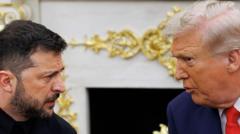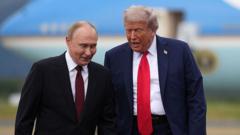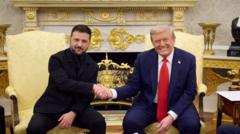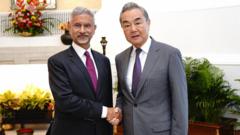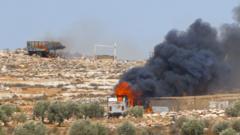Following President Trump’s high-stakes military actions against Iran, a ceasefire has been announced between Iran and Israel, potentially averting further escalation in the region. This development, amid the backdrop of missile exchanges and tensions, marks a pivotal moment in U.S. foreign policy and its implications for stability in the Middle East.
Trump’s Strategic Gambit: Iran and Israel Agree to Ceasefire Amid Tensions

Trump’s Strategic Gambit: Iran and Israel Agree to Ceasefire Amid Tensions
President Donald Trump’s recent military interventions in the Iran-Israel conflict may have led to a temporary ceasefire, raising questions about the effectiveness and consequences of his strategy.
In an unexpected turn of events, U.S. President Donald Trump's controversial military engagement in the ongoing Iran-Israel conflict has led to the announcement of a ceasefire. Dubbed the "12 Day War" by Trump, this episode saw the U.S. conduct airstrikes on Iranian nuclear facilities, prompting retaliatory threats from Iran. In a statement, Iranian Foreign Minister Abbas Araghchi emphasized that Iran would not retaliate if Israeli hostilities ceased by the stipulated time of 4 am Tehran time. Reports indicated that, as this deadline passed, Israeli aggressions appeared to halt, suggesting a de-escalation between the two nations.
The ceasefire agreement comes following Iran's delayed response to the U.S. airstrikes, which targeted its nuclear capabilities. Early assessments post-attacks indicated that Iranian missiles aimed at a major U.S. military base in Qatar were successfully intercepted, sparing American forces from potential casualties. In a subsequent address, Trump characterized Iran's missile launch as a “weak response,” projecting confidence in America’s military posture and hinting at a potential shift toward diplomatic negotiations.
Trump's strategic maneuvering has drawn parallels to his earlier controversial decision to eliminate key Iranian military leader Qasem Soleimani in January 2020, which led to a wave of Iranian missile strikes on U.S. bases but ultimately saw restraint from U.S. forces. Analysts have noted that both instances—while risky—demonstrate a calculated approach from the Trump administration that navigates between military assertiveness and the pursuit of diplomatic solutions.
As the ceasefire unfolds, it remains uncertain what long-term effects this development will have on the already volatile dynamics within the region. Observers are keenly watching for potential further escalations, especially if Iran perceives that its interests are threatened in the wake of current U.S. policies. The changing tides could signal a pivotal moment for U.S.-Iran relations, with implications for oil markets, regional stability, and broader geopolitical alliances. Meanwhile, as the White House engages in backchannel discussions with Qatari intermediaries and Israeli leadership, the ongoing situation underscores the precarious balance of power in the Middle East.
The ceasefire agreement comes following Iran's delayed response to the U.S. airstrikes, which targeted its nuclear capabilities. Early assessments post-attacks indicated that Iranian missiles aimed at a major U.S. military base in Qatar were successfully intercepted, sparing American forces from potential casualties. In a subsequent address, Trump characterized Iran's missile launch as a “weak response,” projecting confidence in America’s military posture and hinting at a potential shift toward diplomatic negotiations.
Trump's strategic maneuvering has drawn parallels to his earlier controversial decision to eliminate key Iranian military leader Qasem Soleimani in January 2020, which led to a wave of Iranian missile strikes on U.S. bases but ultimately saw restraint from U.S. forces. Analysts have noted that both instances—while risky—demonstrate a calculated approach from the Trump administration that navigates between military assertiveness and the pursuit of diplomatic solutions.
As the ceasefire unfolds, it remains uncertain what long-term effects this development will have on the already volatile dynamics within the region. Observers are keenly watching for potential further escalations, especially if Iran perceives that its interests are threatened in the wake of current U.S. policies. The changing tides could signal a pivotal moment for U.S.-Iran relations, with implications for oil markets, regional stability, and broader geopolitical alliances. Meanwhile, as the White House engages in backchannel discussions with Qatari intermediaries and Israeli leadership, the ongoing situation underscores the precarious balance of power in the Middle East.



